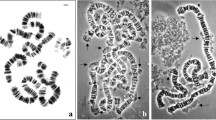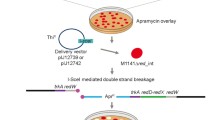Abstract
In Paramecium exconjugants very rapid DNA synthesis takes place in the developing macronuclear anlagen, while DNA synthesis is suppressed in macronuclear fragments. The rate of DNA synthesis in fragments (as a percentage of the rate in anlagen or macronuclei in the same cells) decreases by about 40% during each successive cell cycle over at least the first five cell cycles after conjugation, even though macronuclear anlagen are fully mature by the end of the second cell cycle. — Suppression of DNA synthesis in macronuclear fragments is reversible. If macronuclear anlagen are removed at fission, a very high rate of DNA synthesis resumes in macronuclear fragments after a two-hour lag. The total rate of synthesis in the ensemble of macronuclear fragments in cells without anlagen is greater than that in anlagen in control cells. Thus, suppression of DNA synthesis in macronuclear fragments is not the result of any stable differentiation or irreversible change in the fragments but is the result of, and dependent on, the presence of macronuclear anlagen. — The results of injection of cytoplasm from vegetative cells into normal exeonjugants suggest that normal macronuclei produce an inhibitor which selectively suppresses DNA synthesis in macronuclear fragments. In control cells the relative rate of DNA synthesis in fragments ranged from 40 to 70% of that in anlagen in the same cells, while in injected cells the relative rate of incorporation of DNA precursors was suppressed to as little as 7%. The mean level of incorporation into fragments in injected cells was significantly lower than that in controls, suggesting that the injected cytoplasm contained an inhibitor.
Similar content being viewed by others
References
Allen, S.L.: Genomic exclusion: A rapid means for inducing homozygous diploid lines in Tetrahymena pyriformis, Syngen 1. Science 155, 575–577 (1967)
Barnett, A.: A circadian rhythm of mating type reversals in Paramecium multimicronucleatum, syngen 2 and its genetic control. J. cell. Physiol. 67, 239–270 (1966)
Beers, Y.: Introduction to the theory of error. Cambridge, Mass.: Addison-Wesley 1953
Berger, J.D.: Nuclear differentiation and nucleic acid synthesis in Paramecium aurelia. Dissertation, Indiana University, Order No. 70-7425, University Microfilms, Ann Arbor, Mich. (1969)
Berger, J. D.: Kinetics of incorporation of DNA precursors from injected bacteria into macronuclear DNA of Paramecium aurelia. J. Protozool. 18, 419–429 (1971)
Berger, J. D.: Nuclear differentiation and nucleic acid synthesis in well-fed exconjugants of Paramecium aurelia. Chromosoma (Berl.) 42, 247–268 (1973)
Czihak, G., Grell, K. G.: Zur Determination der Zellkerne bei der Foraminifere Rotaliella heterokaryotica. Naturwissenschaften 47, 211–212 (1960)
Dryl, S.: Antigenic transformation in Paramecium aurelia after homologous antiserum treatment during autogamy or conjugation. J. Protozool. 6 (Suppl.), 25 (1959)
Houck, J. C., Irausquin, H., Leikin, S.: Lymphocyte DNA synthesis inhibition. Science 173, 1139–1141 (1971)
Johnson, R. T., Harris, H.: DNA synthesis and mitosis in fused cells. III. HeLaEhrlich heterokaryons. J. Cell Sci. 5, 649–698 (1970)
Jones, J., Pabaskova-Tchernozenska, E., Moorehead, J. P.: “In vitro” inhibition of DNA synthesis in human leukaemic cells by a lymphoid cell extract. Lancet 1970II, 654–655
Kormos, J., Kormos, K.: Experimentelle Untersuchung der Kernveränderungen bei der Konjugation von Cyclophrya katherinae (Ciliata, Protozoa). Acta biol. Acad. Sci. hung. 10, 396–419 (1956)
Kovaleva, N. E., Jankowski, A. V.: Effect of ionizing radiation on the processes of nuclear reorganizationin in Paramecium putrinum. II. Nuclear processes in exconjugants. Acta protozool. 4, 24–40 (1966)
Lasalvia, E., Garcia-Giralt, E., Macieira-Coelho, A.: Extraction of an inhibitor of DNA synthesis from human peripheral blood lymphocytes and bovine spleen. Rev. Europ. Etudes clin. biol. 15, 789–792 (1970)
Moorhead, J. R., Pabaskova-Tchernozenska, E., Pierrie, E., Hays, C.: Lymphoid inhibition of human lymphocyte DNA synthesis and mitosis “in vitro”. Nature (Lond.) 224, 1207 (1969)
Ossipov, D. V., Skoblo, I. I.: The autogamy during conjugation in Paramecium caudatum Ehrbg. II. The exconjugant stages of nuclear reorganization. Acta protozool. 5, 33–50 (1968)
Seshachar, B. R., Dass, C. M. S.: Macronuclear regeneration in Epistylis articulata. Quart. J. miorosc. Sci. 94, 185–192 (1954)
Sonneborn, T. M.: The relation of macronuclear regeneration in Paramecium aurelia to macronuclear structure, amitosis and genetic determination. Anat. Rec. 78, 53–54 (1940)
Sonneborn, T. M.: Recent advances in the genetics of Paramecium and Euplotes. Advanc. Genet. 1, 263–358 (1947)
Sonneborn, T. M.: Methods in the general biology and genetics of Paramecium aurelia. J. exp. Zool. 113, 87–148 (1950)
Sonneborn, T. M.: Gene-controlled aberrant nuclear behavior in Parameciumaurelia. Microbial Genet. Bull. 11, 24–25 (1954)
Sonneborn, T. M.: Methods in Paramecium research. In: Methods in cell physiology, vol. 4 (D. M. Prescott, ed.), p. 241–339. New York: Academic Press 1970
Author information
Authors and Affiliations
Additional information
Contribution 822, Zoology Department, Indiana University. Supported in part by contract COO-235-66 of the USAEC and by grant No. Gm 15410-05 of the USPHS to T. M. Sonneborn.
This paper is a portion of a dissertation submitted in partial fulfillment of the equirements for the degree of Doctor of Philosophy.
Rights and permissions
About this article
Cite this article
Berger, J.D. Selective inhibition of DNA synthesis in macronuclear fragments in Paramecium aurelia exconjugants and its reversal during macronuclear regeneration. Chromosoma 44, 33–48 (1973). https://doi.org/10.1007/BF00372572
Received:
Issue Date:
DOI: https://doi.org/10.1007/BF00372572




